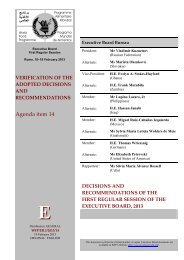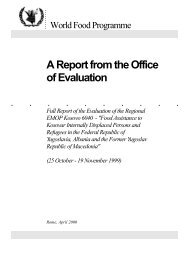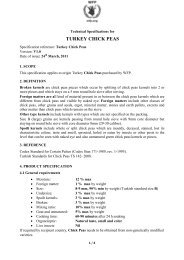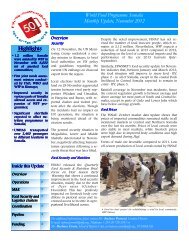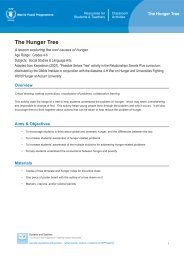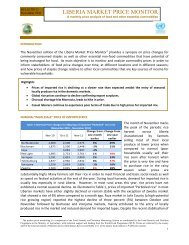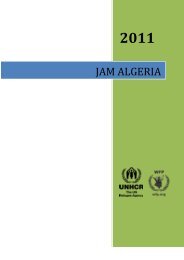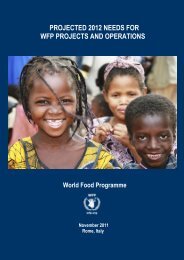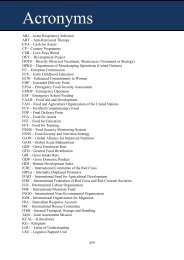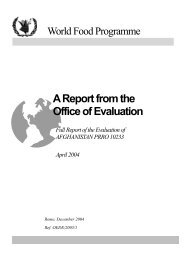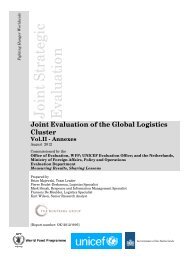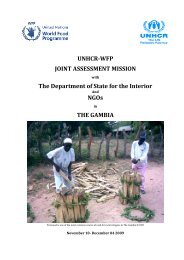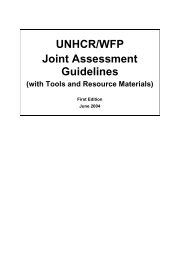The Potential for Scale and Sustainability in Weather Index Insurance
The Potential for Scale and Sustainability in Weather Index Insurance
The Potential for Scale and Sustainability in Weather Index Insurance
You also want an ePaper? Increase the reach of your titles
YUMPU automatically turns print PDFs into web optimized ePapers that Google loves.
30<br />
CHAPTER 2<br />
WEATHER INDEX-BASED INSURANCE<br />
types of <strong>in</strong>dices that can be assessed remotely with satellites, such as cloud cover or soil<br />
moisture content <strong>for</strong> a chosen region dur<strong>in</strong>g critical agricultural periods. This k<strong>in</strong>d of<br />
data is becom<strong>in</strong>g <strong>in</strong>creas<strong>in</strong>gly available <strong>and</strong> it may have the potential to replace<br />
weather stations <strong>for</strong> disaster relief <strong>in</strong>surance. Despite this potential, the writ<strong>in</strong>g of such<br />
contracts <strong>for</strong> <strong>in</strong>dividuals is constra<strong>in</strong>ed by a credibility problem: people may not trust<br />
payout decisions made by <strong>in</strong>surers on the basis of ‘unseen’ data that may, because of<br />
basis risk, fail to correlate highly with their own on-the-ground observations.<br />
Apart from basis risk, <strong>in</strong>surance companies are usually not prepared to design<br />
<strong>in</strong>dex <strong>in</strong>surance products <strong>for</strong> agriculture. <strong>The</strong> adoption of creative solutions such as<br />
the ones mentioned above (e.g. cloud cover, soil moisture) could be quite useful, but<br />
these are even more challeng<strong>in</strong>g <strong>for</strong> most <strong>in</strong>surance companies. As a result, companies<br />
<strong>in</strong> the develop<strong>in</strong>g world usually need significant support <strong>and</strong> tra<strong>in</strong><strong>in</strong>g to design <strong>in</strong>dex<br />
<strong>in</strong>surance contracts, which obviously limits their diffusion <strong>and</strong> expansion.<br />
Re<strong>in</strong>surance<br />
While <strong>in</strong>sur<strong>in</strong>g <strong>for</strong> covariate risks reduces basis risk, it <strong>in</strong>creases the total amount of<br />
payouts <strong>in</strong> any one season, because when an <strong>in</strong>sured event occurs, everyone must be<br />
paid at the same time. Moreover, if the <strong>in</strong>sured risks are <strong>in</strong>dexed aga<strong>in</strong>st different<br />
ra<strong>in</strong>fall stations that happen to be highly correlated, then <strong>in</strong> some years the <strong>in</strong>surer<br />
may have to make very large payments <strong>in</strong> multiple regions. Ontario’s Forage Ra<strong>in</strong>fall<br />
Plan <strong>in</strong>surance, <strong>for</strong> example, has experienced loss ratios vary<strong>in</strong>g between 0.02 (<strong>in</strong><br />
2008) <strong>and</strong> 4.77 (<strong>in</strong> 2001). 7 <strong>The</strong> <strong>in</strong>surer can hedge part of this risk by diversify<strong>in</strong>g its<br />
portfolio to <strong>in</strong>clude <strong>in</strong>dices <strong>and</strong> sites that are not highly <strong>and</strong> positively correlated,<br />
which is more likely possible <strong>in</strong> larger countries. But it may also be necessary <strong>for</strong> the<br />
<strong>in</strong>surer to sell part of the risk to <strong>in</strong>ternational f<strong>in</strong>ancial markets.<br />
International re<strong>in</strong>surance is already available <strong>for</strong> some natural disaster risks. <strong>The</strong><br />
simplest <strong>for</strong>m is a stop-loss contract <strong>in</strong> which the primary <strong>in</strong>surer pays a premium to<br />
get protection if its losses exceed certa<strong>in</strong> levels. Other <strong>for</strong>ms of re<strong>in</strong>surance are also<br />
common. Quota-share arrangements <strong>in</strong>volve shar<strong>in</strong>g both premiums <strong>and</strong><br />
<strong>in</strong>demnities. Despite significant growth <strong>in</strong> recent years, the re<strong>in</strong>surance markets <strong>for</strong><br />
<strong>in</strong>dex <strong>in</strong>surance are still th<strong>in</strong>, with few large <strong>in</strong>ternational firms <strong>and</strong> a limited appetite<br />
<strong>for</strong> weather <strong>in</strong>dex-based contracts.<br />
As an alternative to re<strong>in</strong>surance, recent developments <strong>in</strong> global f<strong>in</strong>ancial markets<br />
are mak<strong>in</strong>g it <strong>in</strong>creas<strong>in</strong>gly feasible to use new f<strong>in</strong>ancial <strong>in</strong>struments to spread<br />
covariate risks more widely, such as weather derivatives <strong>and</strong> catastrophe bonds.<br />
However, the high transaction costs associated with these arrangements have been a<br />
major impediment to their use <strong>in</strong> develop<strong>in</strong>g countries <strong>and</strong> <strong>for</strong> agricultural risk<br />
management. <strong>The</strong>se costs could be reduced if governments play a role <strong>in</strong> aggregat<strong>in</strong>g<br />
risk nationally <strong>and</strong> <strong>in</strong> <strong>in</strong>sur<strong>in</strong>g part of the aggregate risk itself be<strong>for</strong>e go<strong>in</strong>g to the<br />
7 <strong>The</strong> loss ratio <strong>for</strong> an <strong>in</strong>surance company is equal to total claims paid out plus adjustment expenses, divided by<br />
total earned premiums. <strong>Insurance</strong> companies with very low loss ratios are collect<strong>in</strong>g significantly more <strong>in</strong><br />
premiums than they are pay<strong>in</strong>g out <strong>in</strong> <strong>in</strong>demnities, while those with very high loss ratios may not be collect<strong>in</strong>g<br />
enough premiums to pay claims <strong>and</strong> expenses <strong>and</strong> still make a profit.



